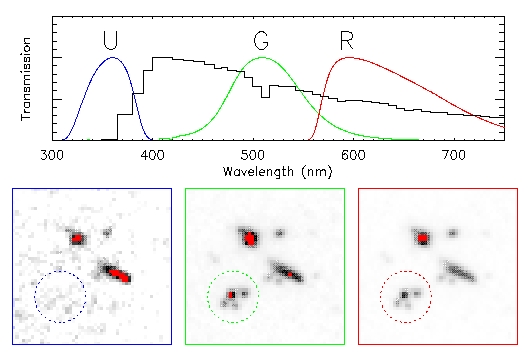Lyman-Break Galaxies are selected by performing deep imaging in three
broad band filters (Ultra-violet, Green, and Red)
as illustrated in the figure. Starforming galaxies at redshifts z>2.5
will be very faint or absent in the U-filter since for z>2.5
this filter is sensitive to flux from the blue side of the Lyman-limit
in the restframe of the galaxy. Very little flux is emitted from the
blue side of the Lyman-limit since, 1) very few stars are hot enough
to produce so energetic photons, 2) photons from the blue side of the
Lyman-limit can ionise neutral hydrogen (the definition of the
Lyman-limit) and hence stand a good chance of being absorbed, and 3)
such photons may also be absorbed by hydrogen clouds along the line of sight
from the galaxy to the earth (mainly in the Ly-α resonance line).
In the figure, a Lyman-Break Galaxy is shown in the dashed circle
(based on Hubble Space Telescope images). As
seen, the galaxy is detected in the G and R filters, but
not in the U-filter.

This technique has been implemented and used very successfully by Steidel,
Hamilton, Pettini, Dickinson, Giavalisco and their
collaborators to collect a substantial (>1000) sample of star-forming
galaxies at high redshifts.
Here is a link to Steidel's page on the Lyman-Break technique. See also Mauro Giavalisco's
article on Lyman-Break galaxies. Another interesting contribution
to this subject can be found here.
The full CalTech LBG survey is available here.
